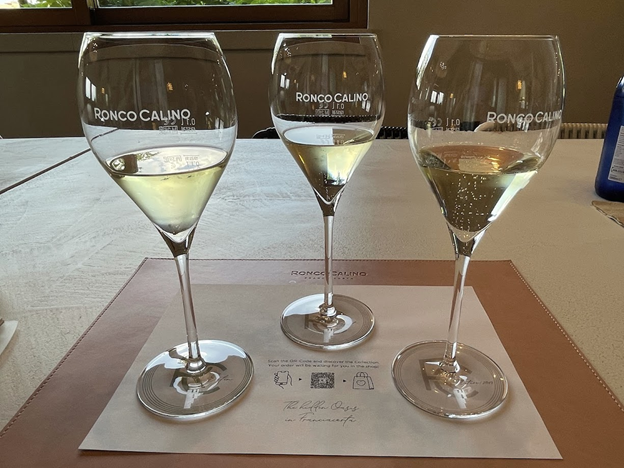How to Map Out a Day Trip to the Wineries in Texas Hill Country
- Marla
- Sep 21, 2023
- 4 min read

A lot of people don’t equate Texas with wine, but it’s actually the 11th largest producer of wine in the United States. The largest American Viticultural Area in the state is Texas Hill Country, a sprawling region sort of in between Austin and San Antonio.
There are over 200 wineries in the region, but they are spread out. Many of them are situated near the town of Fredericksburg, which is almost two hours west of Austin. People often choose to visit that area for an overnight or weekend. Since our home base was Austin, we opted to take a day trip from Austin to the Driftwood area in the North part of Texas Hill Country, only about 40 minutes southwest of the city, where we could visit several different wineries and have lunch at the renowned Salt Lick BBQ.
There are a few tour companies that will take you to the wineries in Texas Hill Country. We chose Lux Limo, which made several suggestions and enabled us to customize our itinerary. We were very happy with the end result, and our driver, Kate, was terrific. Plus it was fun to ride in our private luxury vehicle, which didn’t cost more than the other tour options.
Here’s what we did to map out our visit to the wineries in Texas Hill Country.
Texas Hill Country Wine Background
Winemaking in Texas Hill Country began in the 1880s, but the vast majority of wineries didn’t survive prohibition. Winemaking was resurrected in the region in the 1970s. The area produces many grape varieties, but most are ones that are common in Italy and Spain, such as Albarino, Sangiovese, Grenache, and Tempranillo – not surprising when you think of the climate. Mourvèdre and Syrah are also prevalent.
Note that some of the wineries in Texas Hill Country import grapes from out of state. Texas’s labeling laws were updated in 2021 to require wineries to clarify which wines are 100 percent Texas wines. We wanted to sample only 100 percent Texas wine.
The wineries themselves also vary. Some are much larger than others; some produce drier wines, while others specialize in sweet ones. This is why it helps to map out a trip to the wineries in Texas Hill Country. You’ll want to create the best winery experience for you.
Fall Creek Vineyards

Our first visit was to Fall Creek Vineyards in Driftwood, the first modern Texas Hill Country winery, established in 1975. This is a family-owned winery; the premises used to be a private home. It’s very pretty, with a large fireplace in the middle of the tasting room. You know you’re in Texas; there’s a lot of Texas décor, and the wine awards displayed are belt buckles and saddles, not ribbons or medals.
All of its wine is made from Texas grapes. The winery focuses on whites and rosés; it rounds out its offering of red wines from Salk Lick Cellars, which is right across the street.
We enjoyed a private guided tasting of wines that change each season.
We sampled:
Lescalo (for “less calories”) Chenin Blanc, with lower alcohol and sugars 😊
Chardonnay Vintners Selection 😊++
Roussanne (the winery’s first, not on the tasting menu) 😊
Chez Rosé 😊++
Tempranillo, Vintner’s Selection 😊😊
GSM, a blend of Grenache, Syrah, and Mourvèdre, from Salt Lick Cellars 😊😊
Salt Lick BBQ and Cellars

There’s plenty of BBQ in Texas, but Salt Lick BBQ in Driftwood, established in 1967, is an institution, with a huge indoor pit and recipes that date from the Civil War.
The restaurant’s winery, Salt Lick Cellars, sold its first wine in 2008. It’s located right next door to the restaurant and produces mainly red wines. It only uses grapes grown in Texas.
Since the winery focuses on red wines, and we already had tried the winery’s GSM at Fall Creek, we chose to skip the tasting room and devote our time to having a leisurely BBQ picnic lunch while listening to live music with a bottle of Salt Lick’s Mourvèdre that the winery said paired well with the food. They were right. 😊++

Limestone Terrace Vineyard
Limestone Terrace Vineyard, in nearby Wimberley, was not on our original itinerary. We substituted it after doing some research since we wanted to concentrate on wineries that use 100 percent Texas grown grapes.
Limestone is relatively new, so it’s a bit of a hidden gem. The vineyard on the property had burned down in 2011; the new owners, a family and a partner, revitalized it in 2016.
It’s also “hidden” geographically; unlike some of the other wineries in the area, which are right off the main road, this one is more off the beaten track. We traveled down a dirt road for a bit before arriving at the winery. Kate belongs to this winery’s wine club, a fun fact that also made us feel that we made a good decision by pivoting.
We enjoyed a guided wine tasting in a cozy little room at our own table; one can also sip on the winery’s two-tiered deck.

We sampled:
Albarino 😊😊
Roussanne 😊😊
Dolcetto, a chillable Italian varietal 😊😊
Sangiovese 😊😊
Mourvèdre 😊😊
We hope you find these tips about how to map out a day trip to the wineries of Texas Hill Country useful. Are there any additional wineries or experiences in the region that you recommend? Please let us know! Send us a message at info@winewithourfamily.com.
If you enjoyed this post, go to our website and check out some of our related articles:




Comments